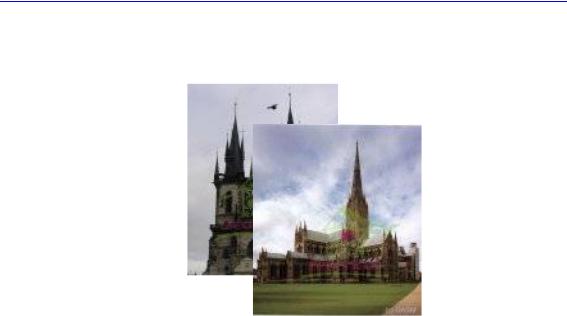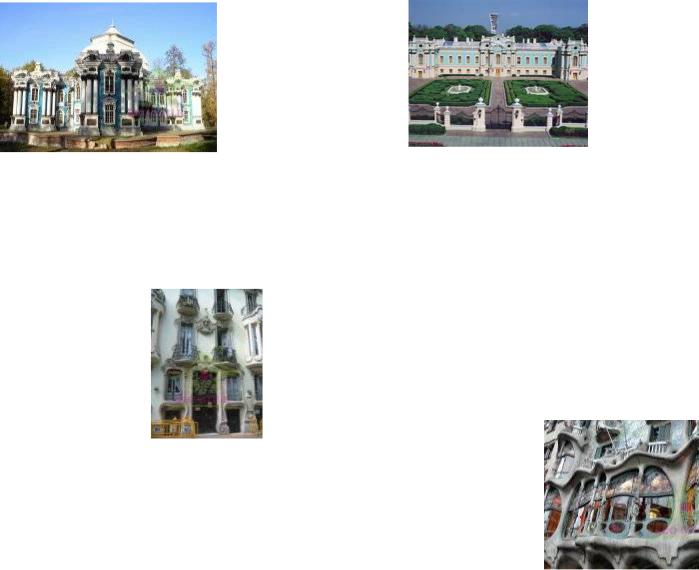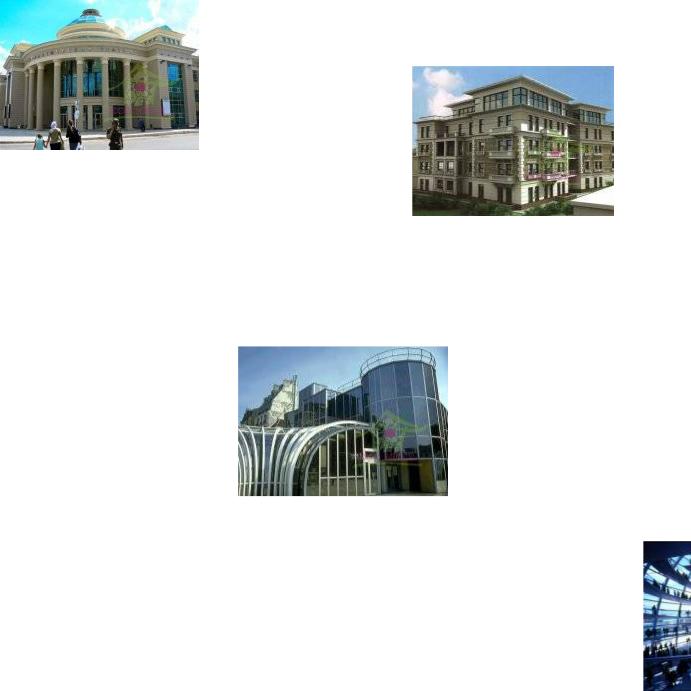
Английский язык.Civil Engineering
.pdf
1.8 Click here, watch the presentation and say what is needed to be a successful engineer.
http://www.youtube.com/watch?v=nz9vMQwzdzI
1.9Speak about your future specialty answering the following questions.
1. What are you?
2. What is your faculty?
3. When was your faculty founded?
4. How many students are there at your faculty?
5. What can you say about the staff?
6. What is your subject?
7. Why have you chosen this profession?
8. Civil engineering is important, isn’t it?
9. Is civil engineering a broad professional field? Why do you think so?
10. What are the duties of a civil engineer?
11. How long does the course of study last?
12. What subjects do you study?
13. What do the students do at the end of the 5-th course?
14. Where do you plan to work after graduation from the University?
1.10Act out the situations:
Discuss with your group-mate why you have chosen the profession of a civil engineer. What are its advantages? Where do you think you
10
will work after you graduate from the university?
Useful phrases:
to be interesting for,
to be fond of architecture, town planning and design,
to be important for the Kuzbuss (our country), the scope of civil engineering, to be broad,
to be easy (difficult), to find a good job in the future.
Unit II: Architecture
2.1 Read, study and try to memorize words and word combinations:
according to |
согласно чему-либо |
|
|
adaptability |
приспособляемость |
|
|
approach |
подход |
|
|
building, syn. structure |
здание, сооружение |
|
|
commodity |
удобство |
|
|
communication |
передача |
|
|
delight |
восхищение, наслаждение |
||
depend upon |
зависеть от |
|
|
design |
проектировать, конструировать |
||
distinguish |
различать |
|
|
drawing |
черчение |
|
|
employ |
применять, использовать |
||
engineering |
инженерное искусство |
|
|
ensemble [αn'sαmb(ə)l] |
ансамбль |
|
|
experience |
знать по опыту |
|
|
firmness |
устойчивость |
|
|
generic |
характерный |
для |
определенной |
|
группы |
|
|
in accordance with |
в соответствии с |
|
|
man-made |
созданный руками человека |
||
permanence, syn. stability |
прочность, устойчивость |
||
possess |
обладать |
|
|
requirement |
требование |
|
|
social formation |
общественно-экономическая |
||
|
формация |
|
|
11
suitability |
пригодность |
|
technique of building |
методика (технические приемы) |
|
строительства |
||
|
||
vary |
меняться |
2.2 Try to recognize the international words. Give Russian equivalents to the following words:
architecture, theorist, civilized, produce, aesthetic, human, social, hospital, function, type, formation, group, religious, commercial, industrial.
2.3 Read the text and find answers in it to the questions given bellow.
What is Architecture?
Architecture is the art and the technique of building, employed to fulfill the practical and expressive requirements of civilized people. Almost every settled society that possesses the techniques for building produces architecture.
Architecture is the science of designing and building structures, or ensembles according to aesthetic and functional criteria. Structures built in accordance with such principles are also architecture.
The Roman architect and theorist Vitruvius (46-30 BC) wrote that architecture needed to possess three qualities, usually rendered in English as commodity, firmness, and delight. Vitruvius required all three elements to be present for a building to be “architecture”. So the characteristics that distinguish a work of architecture from other manmade structures are (1) the suitability of the work to use by human beings in general and the adaptability of it to particular human activities; (2) the stability and the permanence of the work’s construction; and (3) the communication of experience and ideas through its form. All these conditions must be met in architecture. The second is constant, while the first and the third vary in relative importance according to the social functions of buildings.
A historical approach exposes key relationships between architecture and other disciplines – sculpture, drawing, engineering,
12
and town planning, to name a few. Most of us, however, experience architecture in relation to certain generic building types. We live in a house, worship in a religious building, go to work in skyscrapers, spend our money in shopping centers, feed our cars at gasoline stations, stay overnight in a hotel, go to hospitals when we are sick.
The types of architecture are established not by architects but by society, according to the needs of its different institutions. So the types of architecture depend upon social formations and may be classified according to the role of the patron of the community. The simplest classification of architectural types represents the following groups: domestic, religious, governmental, recreational, welfare and educational, commercial and industrial.
1.How can you define architecture?
2.What have you learnt about Vitruvius?
3.What distinguishes a work of architecture from other man-made structures?
4.Which of the conditions that must be met in architecture is constant?
5.Is architecture an autonomous discipline? Speak on its relationships.
6.What are the basic types of architecture?
2.4 Match A with B.
|
A |
B |
|
1. |
technique of building |
a. основные взаимоотношения |
|
2. |
expressive requirement |
b. методика строительства |
|
3. |
man-made structure |
c. передача опыта |
|
4. |
quality |
d. оседлое общество |
|
5. |
key relationships |
e. градостроительство |
|
6. |
communication of experience |
f. например |
|
7. |
relative importance |
g. сооружение, |
созданное |
|
|
руками человека |
|
8. |
settled society |
h. качество |
|
9. |
characteristic |
i. относительная важность |
|
10. town planning |
j. потребность в |
|
|
|
|
выразительности |
|
11. to name a few |
k. особенность |
|
|
13
2.5 The word “architecture” can have many meanings. Depending on the context, architecture can refer to:
a)any man-made building or structure;
b)a man-made building or structure that is important, large, or highly creative;
a carefully designed object, such as a chair, a spoon, or a tea kettle;
c)a design for a city, town, park, or landscape;
d)the art or science of designing and building buildings, structures, objects, and outdoor spaces;
e)a building style or method.
How do you define architecture?
2.6 Act out a dialogue.
Architecture
-What is architecture?
-Architecture is the art and the science of building.
-Can you say what the basic principles in architecture are?
-Oh, they are convenience, strength and beauty. You see, about 2000 years ago the Roman architect Vitruvius called these principles. They are always present in the best structures.
-So, an architect is to achieve an integration of these principles in his work, isn’t he?
-You are quite right.
-There are different architectural styles: Gothic, Baroque, Classicism, Neoclassicism, Modern. Do they reflect a man’s desire for something new?
-First of all, they reflect different social functions. Each generation write its history in buildings. For example, medieval towns were designed and built for protection. The Baroque city is organized for show. American metropolis says: “Finance must dominate”.
-I see. As to modern architecture, it is characterized by simplicity of line and design.
2.7Now try to speak about architecture, its function and styles.
2.8Do you know where these buildings are? Read these newspaper cuttings making use of the vocabulary. Match the
14

descriptions with the buildings. |
|
look like быть похожим |
tripod треножник |
hull корпус судна |
triangular треугольный |
deck палуба |
rectangular прямоугольный |
be shaped быть в форме |
a huge chisel огромное долото |
bottom низ |
empty space пустое пространство |
be connected быть связанным |
dome купол, свод |
skewer шпилька |
square link in a chain квадратное |
|
звено в цепи |
1.This building looks like a huge ship, an ocean liner, sailing up the river. One part of the building is shaped like three hulls. The other part looks like the decks and the bridge.
2.The building looks like
a TV transmitter. It has three spherical structures. The bottom two are connected by a structure
which is shaped like a ladder. It looks like three onions
on a skewer! The foot of the building has legs, like a tripod.
3. It is a triangular at the base, but thin and rectangular at the
15

top. It looks like a huge chisel,
with an empty space in the middle of the blade.
4.The skyscraper is shaped like a giant sail. The sail is standing on a short surfboat in the sea.
5.This building is in three parts. In the centre there is a tall H-shaped building. On the left there’s the top part of a dome. It looks like an upside-down plate. On the right there is the bottom part of a dome, like a soup bowl.
6.It consists of three L-shaped structures, attached to each other. It looks like a square link in a chain.
Useful language: You can describe the shape or appearance of something in these ways:
The building looks like a TV transmitter.
The building is shaped like a dome. It’s a dome-shaped building. The plan is in the shape of an L. It’s an L-shaped plan.
The screen is in the shape of a circle. It’s a circular screen.
2.9Cover up the texts in the previous exercise. Choose and describe one building in the photos, so that other students could guess the letter of the building under description.
2.10Click here; watch the video about what you have just read. Are you impressed? Comment why. http://www.youtube.com/watch?v=fJWgjI04EzU&feature=related
2.11Translate the following texts about different architectural styles in written form. Use a dictionary if it is necessary.
|
Gothic |
|
architecture, |
|
|
architectural |
style |
in Europe |
that |
||
lasted from the mid |
12th century to the |
||||
16th |
century, |
particularly a |
style |
||
of |
masonry |
building. |
In |
the |
|
12th |
– |
13th |
centuries, |
feats of |
|
engineering |
|
permitted |
|
|
|
increasingly |
|
gigantic |
buildings. |
||
16

The rib vault, flying buttress, and pointed (Gothic) arch were used as solutions to the problem of building a very tall structure while preserving as much natural light as possible. Stained-glass window panels rendered startling sun-dappled interior effects. One of the earliest buildings to combine these elements into a coherent style was the abbey of Saint-Debis, Paris (1135 – 44). The High Gothic years (1250 – 1300) were dominated by France, especially with the development of the Rayonnant style. Britain, Germany, and Spain produced variations of this style. Late Gothic (15th-century) architecture reached its height in Germany’s vaulted hall churches. Other late Gothic styles include the British Perpendicular style and the French and Spanish Flamboyant style.
Baroque architecture, architectural style originating in late 16th-
century |
Italy |
and |
lasting |
in |
some |
regions, |
notably |
|
Germany |
|
and |
colonial |
South |
|
America, |
until the |
|
18th |
century. |
|
Complex architectural plan shapes, often based on the oval, and the dynamic opposition and interpenetration of spaces were favoured to heighten the feeling of motion and sensuality. Other characteristic qualities include grandeur, drama and contrast (especially in lighting), set of rich surface treatments, twisting
elements, |
and |
gilded statuary. Architects |
applied |
|
bright colours |
and illusory, vividly painted ceilings. |
|||
Outstanding |
|
practitioners in Italy included Gian |
||
Lorenzo |
|
Bernini, Carlo Maderno, and Guarino |
||
Guarini. |
|
Classical |
elements subdued |
Baroque |
architecture |
in |
France. In central Europe, the |
|
|
Baroque arrived |
late but |
flourished in the |
|
|
works of such architects as the Austrian Johann Bernhard Fischer von Erlach. The late Baroque style is often referred to as Rococo.
Art Nouveau (Modern) although known as Modernista in Spain, and Stile Liberty in Italy, Art Nouveau has become the
general term applied to a highly varied movement at the end of the
17

century. The extensive use of iron and glass in Art Nouveau buildings was also rooted in 19th-century practice. In France bizarre forms appeared in iron, masonry, and concrete, such as the structures of Hector Guiimard for the Paris M¾tro (1900), the Montmartre church of Saint-Jean L’¿vang¾liste (1894 – 1904) by Anatole de Baudot, and the Samaritaine Department Store (1905) in Paris, by Frantz Jourdain (1847 – 1935).
The Classicism that (1750 – 1830) is often known as “Neoclassicism,” in order to distinguish it from
the Classical architecture of ancient Rome or of
the Renaissance. Stylistically this began with an onslaught against Baroque architecture. Neoclassical architecture is based on the
principles of simplicity and symmetry, which were seen as virtues of the arts of Rome and Ancient Greece, and were drawn from the 16th century.
|
High-tech |
|
architecture, |
||
also |
known |
as |
Late |
Modernism |
or |
Structural Expressionism, |
is |
an |
|||
architectural |
style |
that |
emerged in |
the |
|
1970s, |
incorporating |
elements |
of |
||
high-tech industry and |
technology into |
||||
building design. Structural |
Expressionist |
||||
buildings reveal their structure on the outside as well as the inside, but with visual emphasis placed on the internal steel and/or concrete skeletal structure as opposed to exterior concrete walls.
The style’s practitioners include the British architects Sir Norman Foster, Sir Richard Rogers, Sir Michael Hopkins, Italian architect Renzo Piano and Spanish architect Santiago Calatrava, known for his organic, skeleton-like designs. Early High Tech buildings were referred to by historian Reyner Banham as “serviced sheds” due to their additional exposure of mechanical services in addition to the structure. Most of these early examples used exposed
18

structural steel as their material of choice.
2.12 Now summarize the information from the translated texts in a table.
Architectural style |
Years |
Features |
1. |
|
|
2. |
|
|
3. |
|
|
4. |
|
|
5. |
|
|
2.13 Find the English equivalents to the following words and word combinations in the just read texts:
1.опора
2.каменная кладка
3.витражное стекло
4.нервюрный свод
5.мастерство инженерного искусства
6.гармоничный стиль
7.величие
8.освещение
9.позолоченный
10.причудливые формы
11.внутренняя стальная конструкция
12.конструкционная листовая сталь
13.конструкция здания
14.высоко-технологичная промышленность
2.14 Look through the text “Forms and Functions of Architecture” and find two facts which are new to you and two facts which are already known to you.
19
